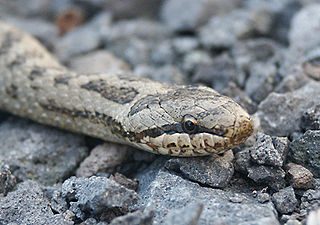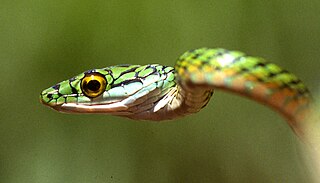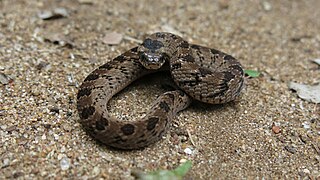
The smooth snake is a species of non-venomous snake in the family Colubridae. The species is found in northern and central Europe, but also as far east as northern Iran. The Reptile Database recognizes two subspecies as being valid, including the nominotypical subspecies described here.
Laurenti is a surname. It may refer to:

Leptophis ahaetulla, commonly known as the lora or parrot snake, is a species of medium-sized slender snake of the family Colubridae. The species is native to Central America and northern South America.

Chironius carinatus, commonly known as the Amazon coachwhip, is a long and slender, nonvenomous colubrid snake.

Chironius is a genus of New World colubrid snakes, commonly called sipos, savanes, or sometimes vine snakes. There are 23 described species in this genus.

Protobothrops mucrosquamatus is a pit viper species endemic to Asia. Common names include: brown-spotted pit viper, Taiwanese habu and pointed-scaled pit viper. No subspecies are currently recognized. The species was first described by Theodore Cantor in 1839.

Trimeresurus purpureomaculatus is a venomous pit viper species native to India, Bangladesh and Southeast Asia. Common names include: mangrove pit viper, mangrove viper, and shore pit viper.
Trachischium laeve, also known as the olive oriental slender snake, is a species of colubrid snake found in Nepal and Indian Himalaya.

Atheris squamigera is a venomous viper species endemic to west and central Africa. No subspecies are currently recognized.

James Ray Dixon was professor emeritus and curator emeritus of amphibians and reptiles at the Texas Cooperative Wildlife Collection at Texas A&M University. He lived in El Campo, Texas, throughout most of his childhood. He published prolifically on the subject of herpetology in his distinguished career, authoring and co-authoring several books, book chapters, and numerous peer reviewed notes and articles, describing two new genera, and many new species, earning him a reputation as one of the most prominent herpetologists of his generation. His main research focus was morphology based systematics of amphibians and reptiles worldwide with emphasis on Texas, US, Mexico, Central America, and South America, although bibliographies, conservation, ecology, life history and zoogeography have all been the subjects of his extensive publications.

Causus defilippii, commonly known as snouted night adder, is a species of snake in the family Viperidae. The species is endemic to East and Southern Africa. Although its venom is nonlethal to humans, it is still considered medically significant. There are no recognized subspecies.

Hypnale nepa, the Sri Lankan hump-nosed viper, is a venomous pitviper species endemic to Sri Lanka where it is known as මූකලන් තෙලිස්සා in Sinhala. Earlier thought that Hypnale walli and Hypnale nepa were two distinct species, but it is now accepted that it is the same species and Hypnale walli is a synonym name. Relatively small, they are distinguished by a strongly upturned snout. No subspecies are currently recognized.
Hypnale walli, or Wall's hump-nosed viper, is a venomous pitviper species endemic to Sri Lanka. The smallest member of its genus, it is distinguished by having a strongly upturned nose and lower scale counts. No subspecies are currently recognized.
Mehelya is a genus name of snakes native to Africa. Some species formerly assigned to the genus Mehelya are now found in the genera Gonionotophis, Gracililima, or Limaformosa. They are collectively called file snakes due to their unusual scalation. They are not venomous.
Raymond Ferdinand Louis-Philippe Laurent was a Belgian herpetologist, who specialized in African and South American amphibians and reptiles. He published more than 200 scientific articles and book chapters. Several species have been named after him, most recently Phymaturus laurenti in 2010. Additional species of reptiles named in his honor include Chironius laurenti, Liolaemus laurenti, and Mehelya laurenti.

Anderson's stream snake, also known commonly as Anderson's mountain keelback, is a species of snake in the family Colubridae. The species is native to Asia

Chironius flavolineatus, also known as Boettger's sipo, is a vine snake species in the family Colubridae, endemic to savannas and semiarboreal biomes in Brazil, and much of South America. It is listed as least concern on the IUCN Red List since 2014. It is a member of the Genus Chironius which is composed of twenty-two other described snake species. It is nonvenomous, using camouflage or burrowing as a form of defense.
Atractus alphonsehogei, also known commonly as Alphonse's ground snake, is a species of snake in the family Colubridae. The species is endemic to Brazil.

Atractus emmeli, also known commonly as Emmel's ground snake and Boettger's ground snake, is a species of snake in the family Colubridae. The species is native to northwestern South America.
Geophis juarezi, also known commonly as Benito Juarez's earth snake and la minadora de Benito Juárez in Mexican Spanish, is a species of snake of in the subfamily Dipsadinae of the family Colubridae. The species is native to Mexico.













